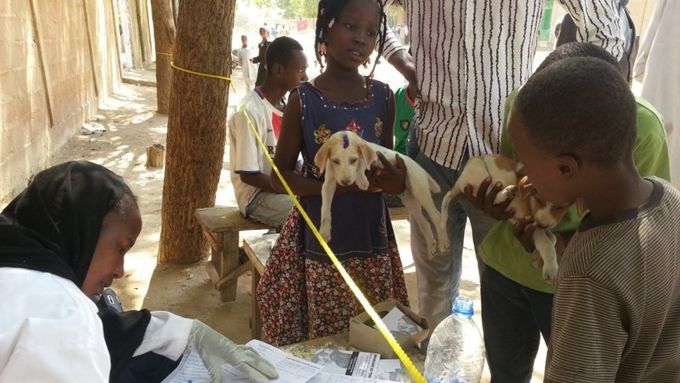Targeted Vaccination to Interrupt Rabies Transmission
28.09.2018
Although the disease is preventable, rabies continues to kill more than 60,000 people per year – mainly children in Asia and Africa. New research by Swiss TPH may pave the way to more targeted dog vaccination in order to eliminate rabies by 2030.

Targeted vaccination campaigns may be sufficient to interrupt transmission of rabies from dogs to humans (Photo: Jakob Zinsstag / Swiss TPH)
The rabies virus is primarily (99%) transmitted to humans through dog bites. Thanks to massive oral vaccination programmes since the 1980s, rabies is now nearly eliminated in Europe. Indeed, the disease is fully preventable thanks to the availability of highly efficacious vaccines and human post-exposure prophylaxis (PEP). Nonetheless, still 60,000 people worldwide die from rabies every year, often due to inaccessibility of appropriate PEP. In order to reach the global goal to eliminate dog-mediated rabies worldwide by 2030, integrated strategies, political will and adequate resources are needed.
More targeted approach suggested
Previous studies have demonstrated that it is feasible to eliminate dog-mediated rabies through mass vaccination campaigns of dogs. In fact, the cumulative cost of mass vaccination of dogs is lower than the cumulative cost of human PEP after 10 years.
In a more recent study, Swiss TPH demonstrated that major outbreaks can be prevented when at least 70% of dogs are vaccinated while minor outbreaks can be explained by a series of importations. The study team tracked the location and contacts of 237 domestic dogs in N'Djamena with geo-located contact sensors. The results showed that most of the dogs had only little contact with other dogs, whereas a few were highly inter-connected.
"Identifying the highly connected dogs would help us develop a more targeted vaccination approach as these dogs hold the most critical role in potentially transmitting rabies." said Jakob Zinsstag, Head of the Human and Animal Health unit at Swiss TPH. "Therefore more research is needed to fight rabies directly in the reservoir. Well-coordinated regional engagement in dog mass vaccination for 10-20 years in Africa and Asia could lead to the elimination of dog rabies at significantly lower cost than the sustained provision of human PEP prophylaxis which has no effect on reducing transmission."
One Health - looking at both humans and animals
Overall, rabies can only be eliminated by applying a One Health approach looking at improving health and well-being of both humans and animals. Swiss TPH scientists have been working on rabies elimination in the sense of One Health together with local partners in Africa for the past 15 years. "Unfortunately, we are currently facing a massive human rabies vaccine shortage globally." said Zinsstag. "More than ever, we need a coordinated effort by all actors, including ministries of health, GAVI and research institutions to end rabies by 2030."
About the publication
Laager M, Mbilo C, Madaye EA, Naminou A, Léchenne M, Tschopp A, et al. (2018) The importance of dog population contact network structures in rabies transmission. PLoS Negl Trop Dis 12(8): e0006680. https://doi.org/10.1371/journal.pntd.0006680
Winter Symposium 2018
The Swiss TPH Winter Symposium 2018 will discuss latest research and new approaches to eliminate rabies and other zoonoses. Join us in Basel on 6 and 7 December 2018 at our Winter Symposium on the topic of "One Health for Humans and Animals - How Do We Get Zoonoses under Control?"